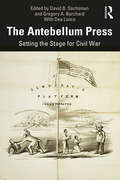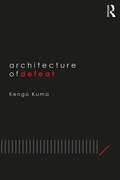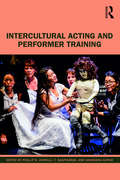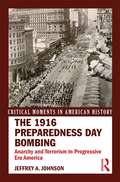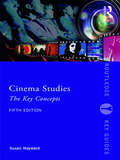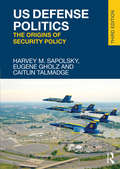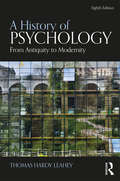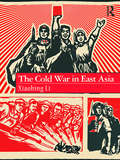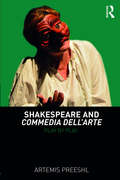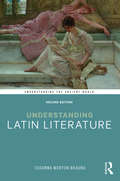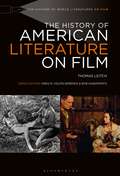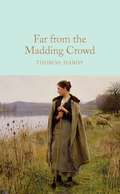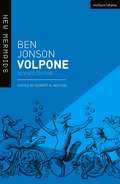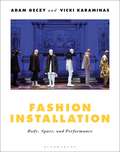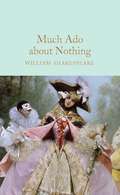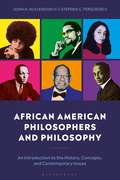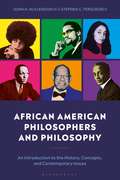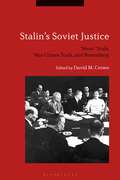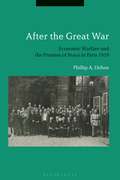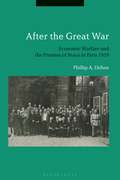- Table View
- List View
The Antebellum Press: Setting the Stage for Civil War
by David B. Sachsman Gregory A. BorchardThe Antebellum Press: Setting the Stage for Civil War reveals the critical role of journalism in the years leading up to America’s deadliest conflict by exploring the events that foreshadowed and, in some ways, contributed directly to the outbreak of war. This collection of scholarly essays traces how the national press influenced and shaped America’s path towards warfare. Major challenges faced by American newspapers prior to secession and war are explored, including: the economic development of the press; technology and its influence on the press; major editors and reporters (North and South) and the role of partisanship; and the central debate over slavery in the future of an expanding nation. A clear narrative of institutional, political, and cultural tensions between 1820 and 1861 is presented through the contributors’ use of primary sources. In this way, the reader is offered contemporary perspectives that provide unique insights into which local or national issues were pivotal to the writers whose words informed and influenced the people of the time. As a scholarly work written by educators, this volume is an essential text for both upper-level undergraduates and postgraduates who study the American Civil War, journalism, print and media culture, and mass communication history.
Architecture of Defeat
by Kengo KumaKengo Kuma, one of Japan’s leading architects, has been combining professional practice and academia for most of his career. In addition to creating many internationally recognized buildings all over the world, he has written extensively about the history and theory of architecture. Like his built work, his writings also reflect his profound personal philosophy. Architecture of Defeat is no exception. Now available in English for the first time, the book explores events and architectural trends in the twentieth and twenty-first centuries in both Japan and beyond. It brings together a collection of essays which Kuma wrote after disasters such as the destruction of the World Trade Center in New York City on 9/11 and the earthquake and tsunami that obliterated much of the built landscape on Japan’s northern shore in a matter of minutes in 2011. Asking if we have been building in a manner that is too self-confident or arrogant, he examines architecture’s intrinsic—and often problematic—relationship to the powerful forces of contemporary politics, economics, consumerism, and technology, as well as its vital ties to society. Despite the title, Architecture of Defeat is an optimistic and hopeful book. Rather than anticipating the demise of architecture, Kuma envisages a different mode of conceiving architecture: guided and shaped by more modesty and with greater respect for the forces of our natural world. Beautifully designed and illustrated, this is a fascinating insight into the thinking of one of the world’s most influential architects.
Architecture of Defeat
by Kengo KumaKengo Kuma, one of Japan’s leading architects, has been combining professional practice and academia for most of his career. In addition to creating many internationally recognized buildings all over the world, he has written extensively about the history and theory of architecture. Like his built work, his writings also reflect his profound personal philosophy. Architecture of Defeat is no exception. Now available in English for the first time, the book explores events and architectural trends in the twentieth and twenty-first centuries in both Japan and beyond. It brings together a collection of essays which Kuma wrote after disasters such as the destruction of the World Trade Center in New York City on 9/11 and the earthquake and tsunami that obliterated much of the built landscape on Japan’s northern shore in a matter of minutes in 2011. Asking if we have been building in a manner that is too self-confident or arrogant, he examines architecture’s intrinsic—and often problematic—relationship to the powerful forces of contemporary politics, economics, consumerism, and technology, as well as its vital ties to society. Despite the title, Architecture of Defeat is an optimistic and hopeful book. Rather than anticipating the demise of architecture, Kuma envisages a different mode of conceiving architecture: guided and shaped by more modesty and with greater respect for the forces of our natural world. Beautifully designed and illustrated, this is a fascinating insight into the thinking of one of the world’s most influential architects.
Intercultural Acting and Performer Training
by Zarrilli Phillip T Sasitharan Anuradha KapurIntercultural Acting and Performer Training is the first collection of essays from a diverse, international group of authors and practitioners focusing on intercultural acting and voice practices worldwide. This unique book invites performers and teachers of acting and performance to explore, describe, and interrogate the complexities of intercultural acting and actor/performer training taking place in our twenty-first century, globalized world. As global contexts become multi-, inter- and intra-cultural, assumptions about what acting "is" and what actor/performer training should be continue to be shaped by conventional modes, models, techniques and structures. This book examines how our understanding of interculturalism changes when we shift our focus from the obvious and highly visible aspects of production to the micro-level of training grounds, studios, and rehearsal rooms, where new forms of hybrid performance are emerging. Ideal for students, scholars and practitioners, Intercultural Acting and Performer Training offers a series of accessible and highly readable essays which reflect on acting and training processes through the lens offered by "new" forms of intercultural thought and practice.
The 1916 Preparedness Day Bombing: Anarchy and Terrorism in Progressive Era America (Critical Moments in American History)
by Jeffrey A. JohnsonThis book places the 1916 San Francisco Preparedness Day Bombing within the broader context of American radicalism and isolationism during the Progressive Era. A concise narrative and key primary documents offer readers an introduction to this episode of domestic violence and the subsequent, sensationalized trial that followed. The dubious conviction of a local labor organizer raised serious questions about political extremism, pluralistic ideals, and liberty in the United States that continue to resonate in the twenty-first century.
Cinema Studies: The Key Concepts (Routledge Key Guides)
by Susan HaywardCinema Studies: The Key Concepts is essential reading for anyone interested in film. Providing accessible coverage of a comprehensive range of genres, movements, theories and production terms, this is a must-have guide to a fascinating area of study and arguably the greatest art form of modern times. Now fully revised and updated for its fifth edition, the book includes entries on topics such as: Acting Audience CGI Convergence Cult cinema Digitisation and globalization Distribution Experimental film Transnational cinema World cinemas
US Defense Politics: The Origins of Security Policy
by Harvey M. Sapolsky Eugene Gholz Caitlin TalmadgeThis book provides an accessible overview of US defense politics for upper-level students. This new edition has been fully updated and revised, with a new chapter on veterans and new material on topics such as cyberwarfare and lobbying. Analyzing the ways in which the United States prepares for war, the authors demonstrate how political and organizational interests determine US defense policy and warn against over-emphasis on planning, centralization, and technocracy. Emphasizing the process of defense policy-making rather than just the outcomes of that process, US Defense Politics departs from the traditional style of many other textbooks. Designed to help students understand the practical side of American national security policy, the book examines the following key themes: US grand strategy; who joins America's military; how and why weapons are bought; the management of defense; public attitudes toward the military and casualties; the roles of the president and the Congress in controlling the military; the effects of 9/11 and the Global War on Terror on security policy, homeland security, government reorganizations, and intra- and inter-service relations. The third edition will be essential reading for students of US defense politics, national security policy, and homeland security, and highly recommended for students of US foreign policy, public policy, and public administration.
A History of Psychology: From Antiquity to Modernity
by Thomas Hardy LeaheyA History of Psychology places social, economic, and political forces of change alongside psychology’s internal theoretical and empirical arguments, illuminating how the external world has shaped psychology’s development, and, in turn, how the late twentieth century’s psychology has shaped society. Featuring extended treatment of important movements such as the Enlightenment and the Scientific Revolution, the textbook approaches the material from an integrative rather than wholly linear perspective. The text carefully examines how issues in psychology reflect and affect concepts that lie outside the field of psychology’s technical concerns as a science and profession. This new edition features expanded attention on psychoanalysis after its founding as well as new developments in cognitive science, artificial intelligence, and behavioral economics. Throughout, the book strengthens its exploration of psychological ideas and the cultures in which they developed and reinforces the connections between psychology, modernism, and postmodernism. The textbook covers scientific, applied, and professional psychology, and is appropriate for higher-level undergraduate and graduate students.
The Cold War in East Asia
by Xiaobing LiThis textbook provides a survey of East Asia during the Cold War from 1945 to 1991. Focusing on the persistence and flexibility of its culture and tradition when confronted by the West and the US, this book investigates how they intermesh to establish the nations that have entered the modern world. Through the use of newly declassified Communist sources, the narrative helps students form a better understanding of the origins and development of post-WWII East Asia. The analysis demonstrates how East Asia’s position in the Cold War was not peripheral but, in many key senses, central. The active role that East Asia played, ultimately, turned this main Cold War battlefield into a "buffer" between the United States and the Soviet Union. Covering a range of countries, this textbook explores numerous events, which took place in East Asia during the Cold War, including: The occupation of Japan, Civil war in China and the establishment of Taiwan, The Korean War, The Vietnam War, China’s Reforming Movement. Moving away from Euro-American centric approaches and illuminating the larger themes and patterns in the development of East Asian modernity, The Cold War in East Asia is an essential resource for students of Asian History, the Cold War and World History.
Shakespeare and Commedia dell'Arte: Play by Play
by Artemis PreeshlShakespeare and Commedia dell’Arte examines the ongoing influence of commedia dell’arte on Shakespeare’s plays. Exploring the influence of commedia dell’arte improvisation, sight gags, and wordplay on the development of Shakespeare’s plays, Artemis Preeshl blends historical research with extensive practical experience to demonstrate how these techniques might be applied when producing some of Shakespeare's best-known works today. Each chapter focuses on a specific play, from A Midsummer Night’s Dream to The Winter’s Tale, drawing out elements of commedia dell’arte style in the playscripts and in contemporary performance. Including contemporary directors’ notes and interviews with actors and audience members alongside Elizabethan reviews, criticism, and commentary, Shakespeare and Commedia dell’Arte presents an invaluable resource for scholars and students of Renaissance theatre.
Understanding Latin Literature (Understanding the Ancient World)
by Susanna Morton BraundUnderstanding Latin Literature is a highly accessible, user-friendly work that provides a fresh and illuminating introduction to the most important aspects of Latin prose and poetry. This second edition is heavily revised to reflect recent developments in scholarship, especially in the area of the later reception and reverberations of Latin literature. Chapters are dedicated to Latin writers such as Virgil and Livy and explore how literature related to Roman identity and society. Readers are stimulated and inspired to do their own further reading through engagement with a wide selection of translated extracts and through understanding the different ways in which they can be approached. Central throughout is the theme of the fundamental connections between Latin literature and issues of elite Roman culture. The versatile and accessible structure of Understanding Latin Literature makes it suitable for both individual and class use.
The History of American Literature on Film (The History of World Literatures on Film)
by Thomas LeitchFrom William Dickson's Rip Van Winkle films (1896) to Baz Luhrmann's big-budget production of The Great Gatsby (2013) and beyond, cinematic adaptations of American literature participate in a rich and fascinating history. Unlike previous studies of American literature and film, which emphasize particular authors like Edith Wharton and Nathaniel Hawthorne, particular texts like Moby-Dick, particular literary periods like the American Renaissance, or particular genres like the novel, this volume considers the multiple functions of filmed American literature as a cinematic genre in its own right-one that reflects the specific political and aesthetic priorities of different national and historical cinemas even as it plays a decisive role in defining American literature for a global audience.
The History of American Literature on Film (The History of World Literatures on Film)
by Thomas LeitchFrom William Dickson's Rip Van Winkle films (1896) to Baz Luhrmann's big-budget production of The Great Gatsby (2013) and beyond, cinematic adaptations of American literature participate in a rich and fascinating history. Unlike previous studies of American literature and film, which emphasize particular authors like Edith Wharton and Nathaniel Hawthorne, particular texts like Moby-Dick, particular literary periods like the American Renaissance, or particular genres like the novel, this volume considers the multiple functions of filmed American literature as a cinematic genre in its own right-one that reflects the specific political and aesthetic priorities of different national and historical cinemas even as it plays a decisive role in defining American literature for a global audience.
Far From the Madding Crowd: The Wild And Wanton Edition (Macmillan Collector's Library #195)
by Thomas HardyFar From the Madding Crowd was the first of Hardy’s novels to give the name of Wessex to the landscape of south-west England and is set against the backdrop of the unchanging natural cycle of the year. The story both upholds and questions rural values with a startlingly modern sensibility.Part of the Macmillan Collector’s Library; a series of stunning, clothbound, pocket sized classics with gold foiled edges and ribbon markers. These beautiful books make perfect gifts or a treat for any book lover. This edition features original illustrations by Helen Allingham and an introduction by Professor Mark Ford.Gabriel Oak is only one of three suitors for the hand of the beautiful and spirited Bathsheba Everdene. He must compete with the dashing young soldier Sergeant Troy and respectable, middle-aged Farmer Boldwood. And while their fates depend upon the choice Bathsheba makes, she discovers the terrible consequences of an inconstant heart.
Volpone: Revised Edition (New Mermaids)
by Ben JonsonThe sharpest, funniest comedy about money and morals in the 17th century is still the sharpest and funniest about those things in the 21st. The full, modernised play text is accompanied by incisive commentary notes which communicate the devastating comic energy of Volpone's satire. The introduction provides a firm grounding in the play's social and literary contexts, demonstrates how careful close-reading can expand your enjoyment of the comedy, shows the relevance of Jonson's critique to our modern economic systems, and provides a clear picture of how the main relationships in the play function on the page and stage. Supplemented by a plot summary and annotated bibliography, it is ideal for students of Jonson, city comedy and early modern drama.
Volpone: Revised Edition (New Mermaids)
by Ben JonsonThe sharpest, funniest comedy about money and morals in the 17th century is still the sharpest and funniest about those things in the 21st. The full, modernised play text is accompanied by incisive commentary notes which communicate the devastating comic energy of Volpone's satire. The introduction provides a firm grounding in the play's social and literary contexts, demonstrates how careful close-reading can expand your enjoyment of the comedy, shows the relevance of Jonson's critique to our modern economic systems, and provides a clear picture of how the main relationships in the play function on the page and stage. Supplemented by a plot summary and annotated bibliography, it is ideal for students of Jonson, city comedy and early modern drama.
Fashion Installation: Body, Space, and Performance
by Adam Geczy Vicki KaraminasGone are the days when fashion relied on a runway launch with coinciding press promotions to show a couturier's new range. Today, design houses are thinking beyond traditional methods of display to stimulate interest in their collections, such as to the internet, fashion film and, more recently, fashion installations. This book offers a critical evaluation of the changing ways in which fashion has been exhibited, focusing specifically on the recent turn toward installation, whether in the form of static presentations, interactive performances or the more conventional curated designer exhibition. Connecting viewers – and consumers – on an immersive level, the fashion world has begun to appropriate installation methods traditionally associated with displays of experimental art, transcending the runway system and its constraints. This book turns to the designers who have pioneered fashion installations, such as Aitor Throup, Muccia Prada, Walter Van Beirendonck and Hussein Chalayan among others, and also looks back to the early influential fashion displays by designers such as Worth and Poiret to provide historical context. Divided into three parts, and covering a variety of installations from Vivienne Westwood's fashioned 'concept' stores to Gareth Pugh's immersive films, this ground-breaking book positions the designer as the curator and exhibition-maker and offers the first focused study of the pertinent concept of fashion installation.
Fashion Installation: Body, Space, and Performance
by Adam Geczy Vicki KaraminasGone are the days when fashion relied on a runway launch with coinciding press promotions to show a couturier's new range. Today, design houses are thinking beyond traditional methods of display to stimulate interest in their collections, such as to the internet, fashion film and, more recently, fashion installations. This book offers a critical evaluation of the changing ways in which fashion has been exhibited, focusing specifically on the recent turn toward installation, whether in the form of static presentations, interactive performances or the more conventional curated designer exhibition. Connecting viewers – and consumers – on an immersive level, the fashion world has begun to appropriate installation methods traditionally associated with displays of experimental art, transcending the runway system and its constraints. This book turns to the designers who have pioneered fashion installations, such as Aitor Throup, Muccia Prada, Walter Van Beirendonck and Hussein Chalayan among others, and also looks back to the early influential fashion displays by designers such as Worth and Poiret to provide historical context. Divided into three parts, and covering a variety of installations from Vivienne Westwood's fashioned 'concept' stores to Gareth Pugh's immersive films, this ground-breaking book positions the designer as the curator and exhibition-maker and offers the first focused study of the pertinent concept of fashion installation.
Much Ado About Nothing: Webster's Spanish Thesaurus Edition (Macmillan Collector's Library #193)
by William ShakespeareComedy and tragedy intertwine when two very different couples fall in and out of love. Part of the Macmillan Collector’s Library; a series of stunning, clothbound, pocket sized classics with gold foiled edges and ribbon markers. These beautiful books make perfect gifts or a treat for any book lover. This edition features illustrations by renowned artist Sir John Gilbert and a new introduction from Professor Tiffany Stern.Whilst Beatrice and Benedick both despise love, exchanging insults and mockery rather than vows, for Hero and Claudio it is love at first sight. But as their marriage preparations begin, so too do Don John’s dirty tricks. Can his scheming get in the way of true love? And can an elaborate plan to bring fiery Beatrice and cynical Benedick closer together really come off? In Much Ado About Nothing, one of Shakespeare’s most popular plays, nothing is quite what it seems.
African American Philosophers and Philosophy: An Introduction to the History, Concepts and Contemporary Issues
by Stephen Ferguson II John McClendon IIIThis book presents the first introduction to African American academic philosophers, exploring their concepts and ideas and revealing the critical part they have played in the formation of philosophy in the USA.The book begins with the early years of educational attainment by African American philosophers in the 1860s. To demonstrate the impact of their philosophical work on general problems in the discipline, chapters are broken down into four major areas of study: Axiology, Social Science, Philosophy of Religion and Philosophy of Science. Providing personal narratives on individual philosophers and examining the work of figures such as H. T. Johnson, William D. Johnson, Joyce Mitchell Cooke, Adrian Piper, William R. Jones, Roy D. Morrison, Eugene C. Holmes, and William A. Banner, the book challenges the myth that philosophy is exclusively a white academic discipline. Packed with examples of struggles and triumphs, this engaging introduction is a much-needed approach to studying philosophy today.
African American Philosophers and Philosophy: An Introduction to the History, Concepts and Contemporary Issues
by Stephen Ferguson II John McClendon IIIThis book presents the first introduction to African American academic philosophers, exploring their concepts and ideas and revealing the critical part they have played in the formation of philosophy in the USA.The book begins with the early years of educational attainment by African American philosophers in the 1860s. To demonstrate the impact of their philosophical work on general problems in the discipline, chapters are broken down into four major areas of study: Axiology, Social Science, Philosophy of Religion and Philosophy of Science. Providing personal narratives on individual philosophers and examining the work of figures such as H. T. Johnson, William D. Johnson, Joyce Mitchell Cooke, Adrian Piper, William R. Jones, Roy D. Morrison, Eugene C. Holmes, and William A. Banner, the book challenges the myth that philosophy is exclusively a white academic discipline. Packed with examples of struggles and triumphs, this engaging introduction is a much-needed approach to studying philosophy today.
Stalin's Soviet Justice: ‘Show’ Trials, War Crimes Trials, and Nuremberg
by David M. CroweFrom the 'show' trials of the 1920s and 1930s to the London Conference, this book examines the Soviet role in the Nuremberg IMT trial through the prism of the ideas and practices of earlier Soviet legal history, detailing the evolution of Stalin's ideas about the trail of Nazi war criminals. Stalin believed that an international trial for Nazi war criminals was the best way to show the world the sacrifices his country had made to defeat Hitler, and he, together with his legal mouthpiece Andrei Vyshinsky, maintained tight control over Soviet representatives during talks leading up to the creation of the Nuremberg IMT trial in 1945, and the trial itself. But Soviet prosecutors at Nuremberg were unable to deal comfortably with the complexities of an open, western-style legal proceeding, which undercut their effectiveness throughout the trial. However, they were able to present a significant body of evidence that underscored the brutal nature of Hitler's racial war in Russia from 1941-45, a theme which became central to Stalin's efforts to redefine international criminal law after the war.Stalin's Soviet Justice provides a nuanced analysis of the Soviet justice system at a crucial turning point in European history and it will be vital reading for scholars and advanced students of the legal history of the Soviet Union, the history of war crimes and the aftermath of the Second World War.
Stalin's Soviet Justice: ‘Show’ Trials, War Crimes Trials, and Nuremberg
by David M. CroweFrom the 'show' trials of the 1920s and 1930s to the London Conference, this book examines the Soviet role in the Nuremberg IMT trial through the prism of the ideas and practices of earlier Soviet legal history, detailing the evolution of Stalin's ideas about the trail of Nazi war criminals. Stalin believed that an international trial for Nazi war criminals was the best way to show the world the sacrifices his country had made to defeat Hitler, and he, together with his legal mouthpiece Andrei Vyshinsky, maintained tight control over Soviet representatives during talks leading up to the creation of the Nuremberg IMT trial in 1945, and the trial itself. But Soviet prosecutors at Nuremberg were unable to deal comfortably with the complexities of an open, western-style legal proceeding, which undercut their effectiveness throughout the trial. However, they were able to present a significant body of evidence that underscored the brutal nature of Hitler's racial war in Russia from 1941-45, a theme which became central to Stalin's efforts to redefine international criminal law after the war.Stalin's Soviet Justice provides a nuanced analysis of the Soviet justice system at a crucial turning point in European history and it will be vital reading for scholars and advanced students of the legal history of the Soviet Union, the history of war crimes and the aftermath of the Second World War.
After the Great War: Economic Warfare and the Promise of Peace in Paris 1919
by Phillip DehneAt the Paris Peace Conference of 1919, the international community came together to find a way forward in the aftermath of the First World War. The conference is often judged a failure, as the resulting Treaty of Versailles did not bring long-term peace with Germany. By following the activities of British delegate and wartime Minister of Blockade Lord Robert Cecil, this book examines the struggles and successes of the conference, as delegates from around the world grappled with the economic, political and humanitarian catastrophes overwhelming Europe in 1919. After the Great War describes, for the first time, the significant role of economic warfare at the Peace Conference and in the post-war settlement. Lord Cecil's sometimes difficult partnership with US President Woodrow Wilson forged a new, permanent, international diplomatic organization – the League of Nations – and supplied it with the power to create collective blockades against aggressive states. Leaders of the Allied economic war before the Armistice became, in Paris, leaders of humanitarian-minded international outreach to their former enemies in Germany and Austria. After the Great War promotes a new understanding of these underappreciated internationalists in Paris, many of whom transitioned into leading the League of Nations even before the Peace Conference ended. Often derided as an idealistic fantasy, international peace enforced by economic sanctions appeared a realistic possibility when the Treaty was signed at the end of June 1919.
After the Great War: Economic Warfare and the Promise of Peace in Paris 1919
by Phillip DehneAt the Paris Peace Conference of 1919, the international community came together to find a way forward in the aftermath of the First World War. The conference is often judged a failure, as the resulting Treaty of Versailles did not bring long-term peace with Germany. By following the activities of British delegate and wartime Minister of Blockade Lord Robert Cecil, this book examines the struggles and successes of the conference, as delegates from around the world grappled with the economic, political and humanitarian catastrophes overwhelming Europe in 1919. After the Great War describes, for the first time, the significant role of economic warfare at the Peace Conference and in the post-war settlement. Lord Cecil's sometimes difficult partnership with US President Woodrow Wilson forged a new, permanent, international diplomatic organization – the League of Nations – and supplied it with the power to create collective blockades against aggressive states. Leaders of the Allied economic war before the Armistice became, in Paris, leaders of humanitarian-minded international outreach to their former enemies in Germany and Austria. After the Great War promotes a new understanding of these underappreciated internationalists in Paris, many of whom transitioned into leading the League of Nations even before the Peace Conference ended. Often derided as an idealistic fantasy, international peace enforced by economic sanctions appeared a realistic possibility when the Treaty was signed at the end of June 1919.
